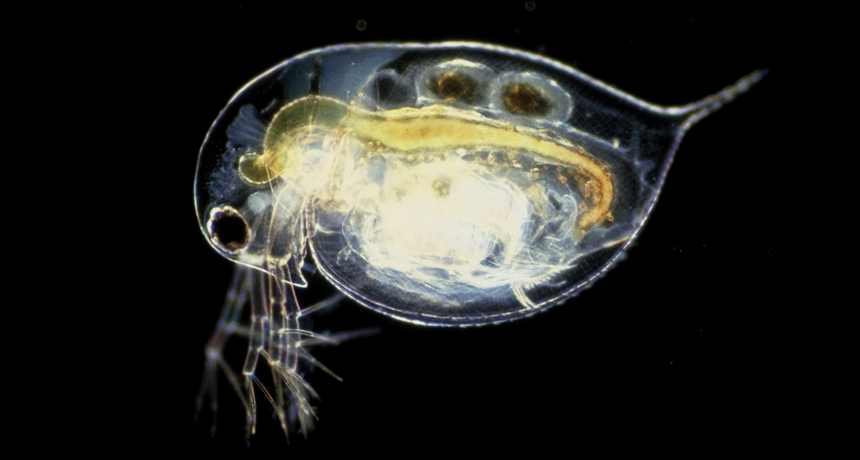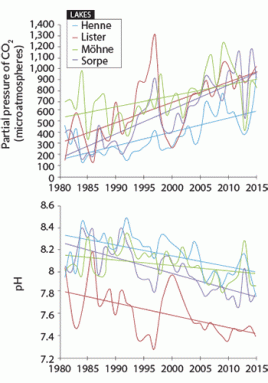Rising carbon dioxide could leave tiny lake dwellers defenseless
The greenhouse gas could alter the ecosystem in many lakes

Water fleas (Daphnia pulex shown) raise spiky defenses when sensing predators are near. But too much carbon dioxide in lake water may dull their senses. That could leave the critters at risk of being eaten.
Paul Hebert (CC BY 2.5)
As people continue to burn fossil fuels, levels of carbon dioxide in the atmosphere have been rising. Some of that excess has dissolved into the world’s oceans. But levels of this greenhouse gas have also been rising in some lakes, a new study finds. Too much of this CO2 in the water may leave some tiny animals in the water too sleepy to fend off predators. This could be a problem because they are an important part of many lake food webs.
These animals are water fleas. Not true fleas, they are a type of tiny crustacean. (As such, they’re related to shrimp and lobsters.) They get their name from the way they appear to jump about in the water. The ones studied here were two different species of pinhead-sized Daphnia (DAFF-nee-uh). They are at the bottom of many freshwater food webs. That means they serve as a primary entrée in the diet of somewhat bigger animals.

Long-term measurements of the chemistry of lake water are rare. But researchers found data on four lakes in Germany. Those data covered the period from 1981 to 2015. They showed how much CO2 levels had risen over that time, as pH levels dropped. (pH is a measure of acidity.)
Rising CO2 in the atmosphere has increased levels of the gas dissolved into Earth’s oceans. That has made them more acidic. Studies show that this ocean acidification alters the behaviors of many species. It’s been less clear whether rising CO2 levels also were affecting lakes and other bodies of freshwater. It also was not clear how freshwater critters might be coping with any change, says Linda Weiss. She’s an aquatic ecologist at Ruhr University Bochum in Germany.
Her team compared the data from the German lakes. Over 35 years, they found, the lakes’ pH fell by an average of 0.01 per year. Carbon dioxide levels increased during that time by a yearly average of 16 microatmospheres. (That is a unit of air pressure.)
And water pH levels fall, the researchers now show, the behavior of the water fleas will change.
The scientists shared these data online January 11 in Current Biology.
Lowering defenses
To probe the pH effects on water fleas, Weiss and her team studied the crustaceans’ behavior in the lab. Predators that feed on Daphnia include the larvae of phantom midges. While dining on the water fleas, those midges release a chemical. Various species of water fleas respond to the chemical by arming themselves with an array of natural defenses. Some raise forbidding neck spikes. Others grow giant “helmets” that make them tougher to swallow.
But in waters with high CO2, the fleas’ ability to sense the predators appeared dulled. They seemed to grow sleepy and unaware of the chemical signaling hungry midges.
The team tested the critters in waters containing both the scary midge chemical and three different levels of CO2. The scientists measure that gas in units known as microatmospheres (microatm). The lowest level was 2,000 microatm. Although it is considered high, this level is now common in lakes. They then compared this to two higher levels, 11,000 and 16,000 microatm. Both species of flea were less defensive at the higher levels of CO2. They displayed fewer neck spikes or developed smaller crests.
Further tests revealed that the elevated CO2 was responsible. It was not due to the more acidic pH. It’s unclear exactly why higher CO2 levels lower the Daphnias’ defenses. However, the researchers suggest the gas may act as a narcotic and blunt the water flea’s senses.
The chemistry and environment of lakes can vary widely. As such, Weiss says, it is difficult to draw firm conclusions from the new findings. Many lakes are warming. And many are already saturated in carbon dioxide and now shedding the excess to the air. Others are still absorbing it and becoming more acidic.
Caleb Hasler is a biologist in Canada at the University of Winnipeg in Manitoba. He was not involved in the study. Hasler says it also is unclear how other freshwater species — including predators — might be affected by growing CO2 levels in water.
Occasional studies have looked at, as here, particular species. Maybe they were plankton. Or fish. Or shellfish. And looking at all of these, he says, “The effect seems to be highly variable.”
Still, studies such as the new one on water fleas show that measuring long-term changes in CO2 and biological impacts will be important to understanding ecosystem effects, Hasler says. And for starters, he says, “Showing that there is an impact on an important species is pretty significant.”







